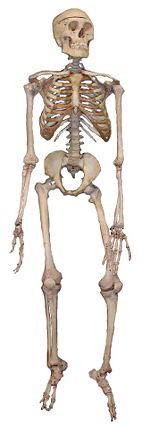Human anatomy is primarily the scientific study of the morphology of the adult human body.[1] Anatomy is subdivided into gross anatomy and microscopic anatomy.[1] Gross anatomy (also called topographical anatomy, regional anatomy, or anthropotomy) is the study of anatomical structures that can be seen by unaided vision.[1] Microscopic anatomy is the study of minute anatomical structures assisted with microscopes, which includes histology (the study of the organization of tissues),[1] and cytology (the study of cells). Anatomy, physiology (the study of function) and biochemistry (the study of the chemistry of living structures) are complementary basic medical sciences where are usually tought together (or in tandem).
In some of its facets human anatomy is closely related to embryology, comparative anatomy and comparative embryology,[1] through common roots in evolution; for example, much of the human body maintains the ancient segmental pattern that is present in all vertebrates with basic units being repeated, which is particularly obvious in the vertebral column and in the ribcage, and can be traced from very early embryos.
The human body consists of biological systems, that consist of organs, that consist of tissues, that consist of cells and connective tissue.
The history of anatomy has been characterized, over time, by a continually developing understanding of the functions of organs and structures in the body. Methods have also advanced dramatically, advancing from examination of animals through dissection of preserved cadavers (dead human bodies) to technologically complex techniques developed in the 20th century.

